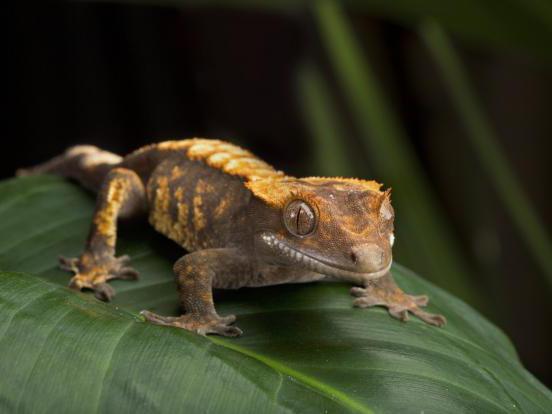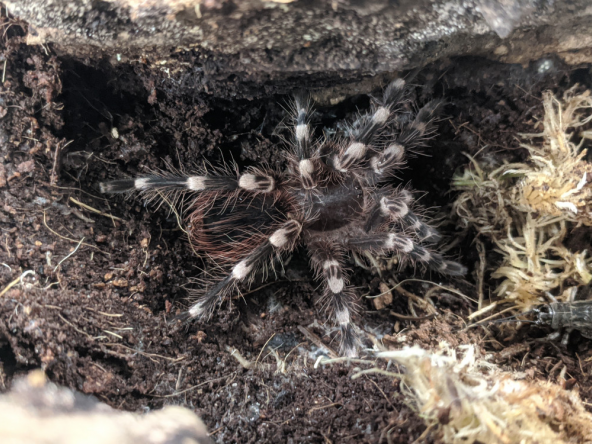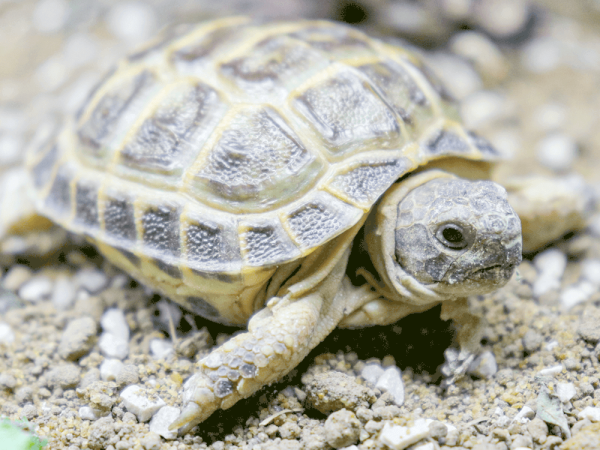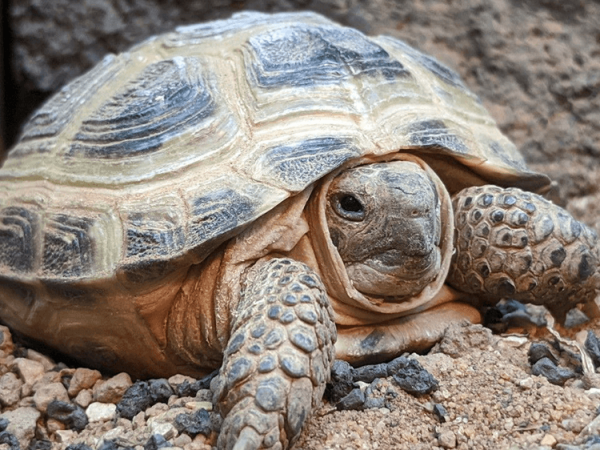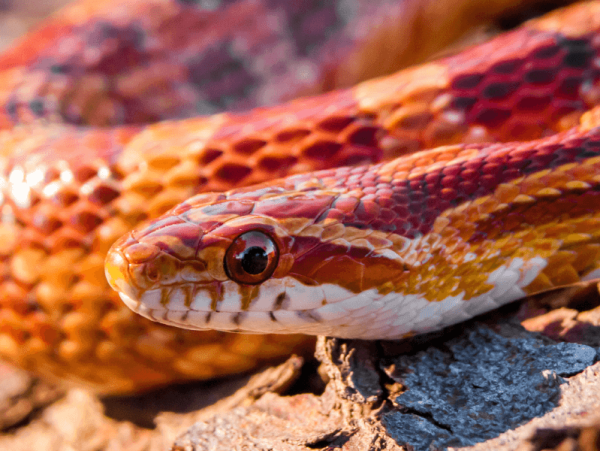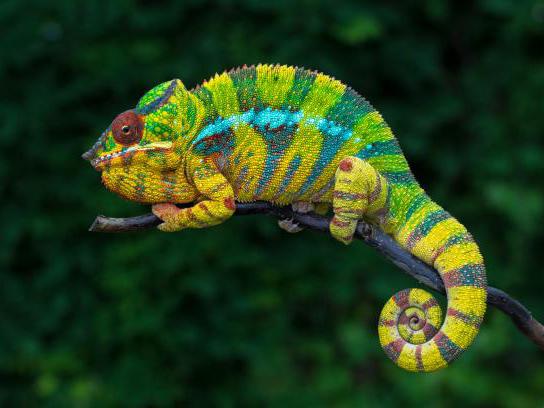Optional extras
Crested gecko, Correlophus ciliatus, care sheet
Categories: Care sheetsLizards
Crested gecko natural history
Crested geckos are medium-sized, crepuscular, arboreal rainforest geckos endemic to the Island of New Caledonia. They were first described in 1866, but were not seen again until 1994, and were presumed extinct until they were 'rediscovered' following a tropical storm. Adult crested geckos grow to around 20cm (8") long and can live to around 10-15 years in captivity.
Crested geckos have a few distinctive features, including the spines that run along their back and head, giving the appearance of eyelashes, and their semi-prehensile tail which they use to grip onto branches and vines. There is quite a bit of variation in pattern and colour of even wild Crested geckos, which also means there are a lot of different morphs available in captivity.
Due to their ease of care, ease of breeding, cute appearance and docile temperaments, Crested geckos have quickly become one of the most popular pets for reptile keepers. They're a great choice for beginner and younger keepers, whilst also remaining a favourite staple for more experienced keepers.
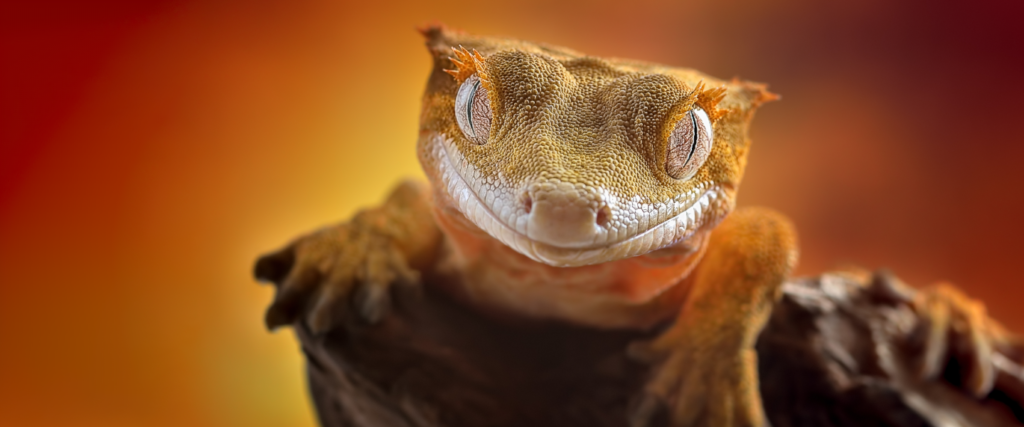
Crested gecko housing
Housing crested geckos is quite easy, since they're arboreal, they require a lot of vertical space rather than horizontal space, meaning it is often easier to fit their enclosure into smaller spaces in the home.
Although you're unlikely to see your Crested gecko moving around too much during the day, they are quite active during their crepuscular waking hours (dusk and dawn), so we recommend a minimum enclosure size of 45 x 45 x 90cm (18 x 18 x 36") for an adult Crested gecko. Generally, a glass terrarium is a better option for this, due to the higher humidity requirements, wooden enclosures are unlikely to last.
Crested geckos are a solitary species and can get quite territorial, particularly male geckos. We, therefore, recommend against keeping this species in pairs or groups, as this can often lead to fights and even if no fighting is observed, competition over resources will occur.
To make things even easier, why not take a look through our range of Crested gecko starter kits?
Crested gecko heating
Crested geckos thrive in slightly lower temperatures than many other reptiles, preferring a temperature range of 28°C (82°F) in the warm end and around 22°C (72°F) in the cool end. Due to their arboreal nature, this temperature gradient should run from warm at the top of the enclosure to a cooler area at the bottom, as would be experienced in their natural environment.
The easiest way to achieve this is using a dome-type lamp holder either rested on or suspended above the mesh top of the enclosure with a basking lamp or ceramic heat emitter fitted. All heating equipment must be hooked up to a compatible thermostat to ensure their safety, if opting for a basking lamp, a dimming thermostat is required, alternatively if using a ceramic heater, a pulse thermostat is required.
Because of the enclosure size and orientation, the use of a heat mat is not recommended, as this will not work well enough to warm the ambient air temperature and create the required thermogradient for a Crested gecko, rather, it would warm the immediate area around the heat mat and no further.
Unless your home drops below around 15°C (59°F) overnight, you will not require any additional heating for the nighttime, however, if it is required, a non-light emitting heat source such as a ceramic heater can be used, set to lower temperatures than during the day to mimic a natural overnight temperature drop.
Crested gecko lighting
Crested geckos were long kept without the use of UV lighting, as it was believed that due to their crepuscular nature they did not require it. However, more often than not this led to the geckos developing metabolic bone disease, deformities and often fatalities. More recently, research has shown that the addition of low-level UVB lighting for a Crested gecko is extremely beneficial, decreases the risk of a plethora of illnesses and leads to a much more healthy gecko.
The ideal UVI for Crested geckos is between 1-2, which is most easily achieved using the Arcadia ShadeDweller ProT5 Kit placed 25-40cm (10-15”) above the Gecko's highest basking point. If the distance between the highest basking point and the light fixture will be greater than 40cm (15”), but no higher than 45cm (18”), then you will require the slightly more powerful Arcadia ProT5 Kit - Forest 6%.
Crested gecko humidity
As rainforest reptiles, Crested geckos prefer a higher humidity range, although they do not fare well with constant high humidity which can lead to the development of respiratory infections. Rather, they prefer a nighttime mist bringing the humidity up to around 70-80% and for this to then drop to around 50-60% throughout the day.
This is quite easily achieved using a simple handheld spray bottle to mist the enclosure, or you can opt for an automated fogger or rain system hooked up to a timer to do it for you. Crested geckos will rarely drink from a water bowl, preferring to drink from water droplets or small puddles on plant leaves and decor pieces, so if you choose a fogger, it is still important to give the enclosure a little mist to allow such droplets/puddles to form.
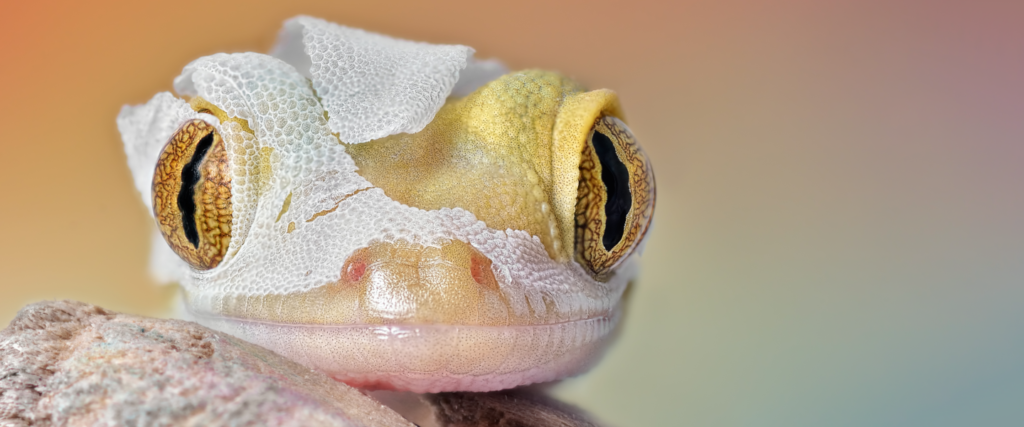
Crested gecko substrate
To keep the humidity slightly higher, a moisture-retaining substrate such as coco soil should be used for Crested geckos. If you plan to also keep live plants in the enclosure, however, it would be better to opt for a bioactive substrate with a little more texture.
If you do opt for live plants, you will also need to add a drainage layer below your substrate layer, to allow excess water to drain down rather than sitting around the roots of your plants which is likely to rot them.
For more information regarding the use of live plants in reptile enclosures and suitable substrates for them, please refer to our dedicated live plant help guide.
Crested gecko tank decoration
Crested geckos are quite a shy species, and will feel threatened without enough hiding places, so lots of cover in the canopy is vital. You should first lay in your hardscape, so pieces of wood, branches and vines, ensuring you use plenty to allow your gecko to utilise all of the vertical space in the enclosure.
Once you have the hardscape in, you can start adding foliage either with your live plants or artificial plants. This is what your gecko will mainly use to hide in and feel secure, so again, it is important that you use plenty to provide cover across the whole length of the enclosure.
Crested gecko diet
Crested geckos are omnivores, and would naturally feed on a mixed diet of rotting fruits and live insects. In captivity, this diet can be difficult to achieve whilst still providing your gecko with all the nutrients they require to be healthy. Due to this, there are many high-quality formulated gecko diets on the market with a wide range of flavours to choose from, from leading brands such as Pangea or Repashy which should be fed every two to three days.
Although the formulated diets will form a large part of your Crested geckos diet, you still need to feed Crested geckos live foods such as Crickets, Locusts and small Roaches which should be offered once or twice a week.
All live food should be dusted with supplements, following a set 8 meal cycle. For this, we recommend the use of a high-quality multivitamin on every feed, such as Arcadia EarthPro-A, a calcium plus magnesium supplement on every fourth feed, such as Arcadia CalciumPro Mg and finally, a vitamin D3 supplement on every eighth feed such as Arcadia EarthPro RevitaliseD3.
Crested gecko breeding
The wild breeding season for Crested geckos would usually begin in Spring and end in Autumn, although in captivity they will readily breed year-round it is still important to give them a few months of rest between breeding seasons.
Due to how readily they breed and the ease of incubation, many inexperienced keepers have taken to breeding their Crested geckos, which has led to the oversaturation of captive-bred Crested geckos with poor genetics in the hobby. It is for this reason that we recommend against breeding for less experienced keepers with what some may consider to be 'low quality' Geckos.
Female Crested geckos are sexually mature when they reach around 38-40g, which is usually at around 18 months old, whereas male Crested geckos can be sexually mature slightly earlier. Once you are sure that your Gecko's are ready to breed, you can pair them up and leave them together throughout the breeding season, unless you see too much stress being put on the female, at which point you should split them up - females can retain sperm for months, so you may also choose to take the safe route and separate them once they have copulated.
Your female Crested gecko will lay clutches of two eggs at a time, and can lay these every 30-45 days throughout the season, and it usually becomes quite clear when she is ready to lay, as you will be able to clearly see the outline of the two eggs in her stomach, at which point, you should ensure she has an appropriate place to lay them in the form of a lay box filled with a loose, damp substrate.
Once the eggs are laid, they must be removed and incubated in a tub with an incubation medium, ensuring that the eggs remain in the exact same orientation that they were laid in, otherwise, you can cause the embryo to drown in the amniotic fluids.
Crested gecko eggs can incubate at room temperature, so there is no need to use a temperature-controlled incubator with them, simply find a safe place and leave them to develop for around 60-120 days before they hatch.
Care for baby Crested geckos is very similar to that of an adult Crested gecko. They will survive off nutrients from their egg yolk in the first week of life, after this, they will have their first shed, at which point you can begin feeding every day or every other day, to the same supplementation schedule as you would for an adult.
Alternative species
If you like the sound of a pet Crested gecko but aren't 100% sold, there are some other options with similar temperaments or care requirements that may be more appealing to you. For example, although they have vastly different care requirements, Leopard geckos make great pets, with their equally calm disposition when compared with Leopard geckos, and they're very easy to care for.
If you'd prefer something with similar care requirements instead, there are some other geckos from New Caledonia such as Leachianus geckos or Gargoyle geckos which can make great pets, although they are a little more specialist than Crested geckos due to different sizes and levels of hardiness.
If a Crested gecko sounds like the perfect pet for you, why not check if we have any in stock, or even contact our store team to discuss the details and find the right Crested gecko for you.
Crested gecko care sheet at a glance
Common names: Crested gecko, Eyelash gecko, Crestie
Scientific name: Correlophus ciliatus (previously Rhacodactylus ciliatus)
Country: New Caledonia
Captive-bred: Yes
Adult size: 20cm (8")
Natural habitat: Forest habitats favouring dense foliage
Housing: Vertical enclosures (90cm/3ft tall minimum)
Ideal temperature: 28°C (82°F) (warm end); 22°C (72°F) (cool end)
UVI: 1-2
Ideal humidity: 70-80% with drops to 50-60%
Diet: Omnivorous
Average lifespan: 10-15 years
Personality: Docile, sometimes jumpy
Ease of handling: Easy
Cohabitable: No
Crested gecko shopping list
- 45 x 45 x 90cm (18 x 18 x 36") terrarium (minimum)
- Heat lamp dome
- Basking lamp or ceramic heater
- Thermostat (dimming or pulse depending on the heat source)
- T5 lighting kit
- Digital thermometer x2
- Humidity gauge (hygrometer)
- Water bowl
- Substrate and drainage if required
- Branches, vines and decor
- Formulated gecko diet
- Supplements (multivitamin, calcium + mg and D3)
- Spray bottle, mister or rain system
- Reptile safe disinfectant
While you're thinking about caring for your new Crested gecko, why not take a look through our range of Crested gecko starter kits? Designed so that you can get everything you need to get started in one go, at a great price!
Becky Bates has always had a fascination with animals, particularly reptiles, amphibians, and invertebrates from a young age. A graduate of Zoology, she is a dedicated and experienced reptile keeper providing top-notch advice and care to Swell Reptiles customers. With her extensive experience with animal biology and behaviour, she understands the importance of promoting a healthy, safe, and happy environment for all animals.




